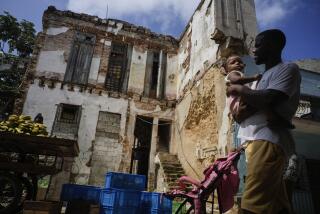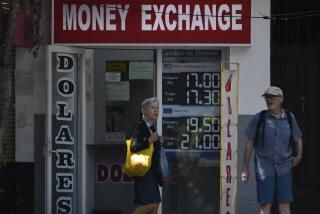Cuban Economy Shows Signs of Growth
- Share via
HAVANA — Container ships laden with food and consumer goods from Europe and Asia plow daily into Havana Bay, a body of water virtually empty five years ago. The merchandise is destined for the dollar stores once limited to foreigners, but now frequented more by Cubans.
Huge cranes stretch high into the gray winter sky above construction crews building hotel and office towers on the few vacant lots remaining along Havana’s broad Fifth Avenue.
Bit by bit, Cuba’s economy is recovering after the collapse of the Soviet Union a decade ago, an event that led the island’s gross national product to shrink by 40%.
The economy grew 5.6% last year and is projected to increase another 5% in 2001, Economics Minister Jose Luis Rodriguez reported in late December. Both rates were well ahead of the Latin American average of 3%.
But Rodriguez acknowledged that the effects of economic growth have yet to trickle down to ordinary Cubans.
“Important limitations are still faced when it comes to people’s daily lives,” Rodriguez acknowledged in his annual report to Cuba’s National Assembly.
Prices for non-rationed food remain extremely high for most Cubans, said Rodriguez, and more homes need to be repaired and built, and public transportation must be improved.
“There are a lot more things to buy now, but our pensions are the same,” said Lifa Isabel Barroso, a retiree in her 60s who sells crocheted shawls and doilies to tourists in Old Havana. Her monthly pension is 80 pesos, the equivalent of a little more than $4.
While Barroso does earn a few more dollars every week, she says she must pay taxes, leaving little to support herself and her ailing parents.
“I am just glad to have a few dollars to buy them meat occasionally,” she said.
Still, things are much better than the early 1990s--grim years marked by severe shortages of food, petroleum and just about everything else. Cubans went months without eating meat, blackouts were regularly scheduled to save fuel, and the streets were deserted because there wasn’t any gasoline available.
“Life can still be difficult for all Cubans,” especially elderly people who need special foods and medicines, said Augustin Cruz, 42, who sells wooden statues at an artisan market. “But overall, the economic situation is about 80% better than 1993,” the year that’s generally considered the roughest for those who endured.
At a farmers’ market created in 1994 as a way to ease economic hardship, Cuban housewives one recent day jostled each other to examine the mounds of red, ripe tomatoes and to pile yucca root onto battered metal scales. Around the corner, drivers line up in old Russian sedans and an increasing number of new cars to fill their tanks.
Much of Cuba’s current economic growth has been attributed to tourism, which Rodriguez described as “the most dynamic factor in our economy”--the industry has grown at an average of nearly 19% a year over the last five years.
Cuba offers visitors many of the same attractions found elsewhere in the Caribbean: white beaches, swimming, fishing and diving. But many tourists come here because of the island’s singular history, its famed cigars and African-influenced music.
Tourism failed to live up to expectations in 2000, when 1.8 million people visited the island. It was only a 10% increase over 1999.
Foreign investment, meanwhile, “continues growing and playing a complementary role in our development,” Rodriguez said.
Since foreign companies got the green light to invest on the island in 1995, 370 “mixed enterprises”--partnerships between outside investors and the Cuban government--have been formed. By year’s end, that translated into foreign investment of $4.3 billion.
Foreign Investment in Tourism Ventures
Many of the mixed enterprises are tourism-related. The Spanish hotel firm Sol Melia S.A. is the largest--it manages 19 hotels on the island and has two more nearing completion. The French company Pernod has a joint venture to distribute Havana Club rum and Italy’s Telecom Italia is a partner with the government in running Cuba’s telephone company.
The sugar crop, once all-important, has suffered under chronic drought and officials expect only 3.7 million metric tons from the current harvest, down about 10% from a year earlier.
Such news would once have been devastating, but the Soviet collapse taught Cuban authorities the dangers of keeping all of their financial eggs in one basket. Economic planners diversified by developing tourism, fish exporting and mining industries.
The government has also been slowly raising salaries and increasing government subsidies for health, education, basic foodstuffs and other services Cubans consider a birthright. Sixty-two percent of government spending for 2001 has been allocated for such services.
The average monthly government salary over the last year increased 7.3% to 249 pesos, which works out to a bit less than $12 at government exchange rates.
The salary figure can mislead because most Cubans pay little or nothing for housing and utilities and enjoy free education and health care and heavily subsidized public transportation. They also receive about half of their food through a government ration program for about 25 pesos a month--the equivalent of about $1.20.
But Cubans still must buy the rest of their food elsewhere, often at much higher prices at dollar stores and farmers’ markets.
“Food is no longer a problem at my house,” artisan Cruz said. “But that is not true for everyone.”
More to Read
Sign up for Essential California
The most important California stories and recommendations in your inbox every morning.
You may occasionally receive promotional content from the Los Angeles Times.










